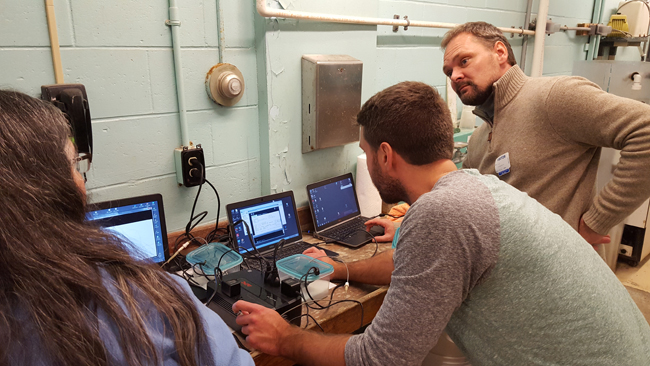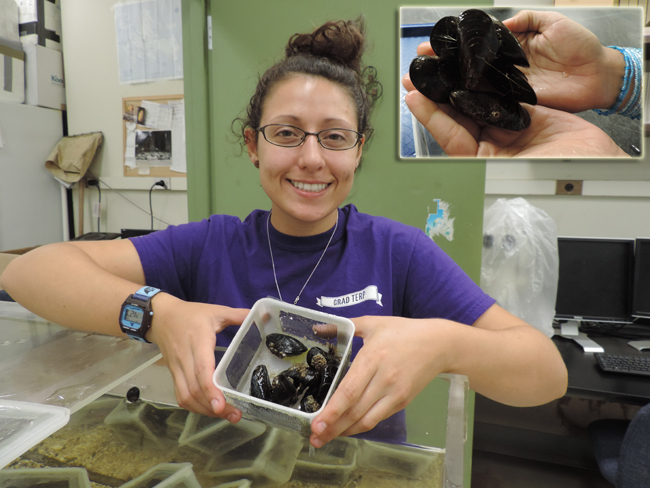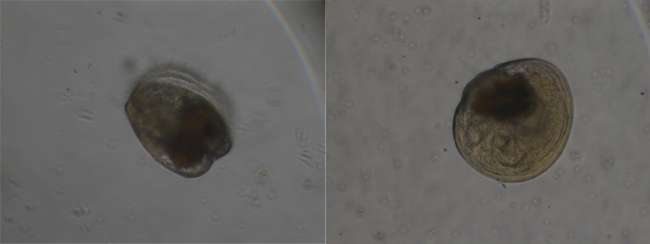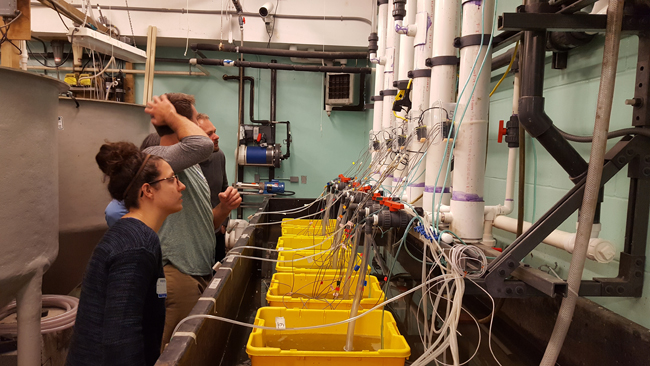
Nils Volkenborn (at far right) and Sam Gurr (center) calibrating the heart rate monitors that were attached to blue mussel shells. Credit: Maria Rosa.
— By Chris Gonzales, Freelance Science Writer, New York Sea Grant
Stony Brook, NY, May 24, 2021 - It’s well known that humans have been releasing carbon dioxide into the atmosphere over the past century, which poses a growing problem because this greenhouse gas causes climate change. It’s perhaps less well known that the oceans have been absorbing about a third of this excess carbon dioxide, leading to a related problem known as ocean acidification (OA). This excess carbon in the ocean’s waters leads to heightened levels of acidity, harming marine life.
OA is particularly a problem for shellfish such as oysters, clams, and mussels. It makes it harder for them to develop sturdy shell material, for one, leaving them more vulnerable to predators.
In the realm of aquaculture—where shellfish are grown for food—scientists are working to identify species that might be well suited to adapt to changing acidic conditions.
Dianna Padilla, from Stony Brook University's (SBU) School of Marine and Atmospheric Sciences (SoMAS), chose to study blue mussels (Mytilus edulis), a species of shellfish increasing in popularity among shellfish farmers.
“Currently, OA is impacting shoreline areas, like Long Island Sound, at a greater rate than the open ocean,” said Padilla. “Bivalves, like clams, oysters, and mussels, are particularly vulnerable to negative impacts of OA, especially their early life stages, or larvae.”

Blue mussels were collected from different regions around Long Island Sound where they currently experience different environmental conditions. Allison Rugila (pictured) is a graduate student in Ecology and Evolution and was the Sea Grant Fellow on this New York Sea Grant project. Credit: Dianna Padilla.
Blue mussel advantage
Padilla and her team conducted long-term experiments, over two generations, with blue mussels from different populations around Long Island Sound.
They wanted to know whether the blue mussel could be a hardy, commercially significant bivalve capable of surviving under possible future ocean conditions affected by OA.
Scientists collected blue mussels from sites around Long Island Sound with different water quality conditions. They then spawned and reared their larvae to produce juvenile mussels, which they then grew in the laboratory to mimic different water quality conditions affected by OA. Padilla’s team was funded by New York Sea Grant.

Blue mussel veliger larvae. Credit: Julia Rose, NOAA Milford Lab.
Surprising and exciting results
Padilla’s team found that mussels from some populations were not affected by different levels of OA, one population was extremely sensitive to increased OA, and another actually performed better under OA conditions.
Mussels from sites with near-oceanic water conditions (Groton CT, and Orient Point, NY) were robust to all but extreme OA conditions.
These results suggest that there is current robustness to OA in certain populations, and the capacity to adapt to present and future OA conditions in animals from many populations.
Padilla and her team predicted that offspring of mussels from more stressful environments, such as the western Long Island Sound, would be more resilient to the effects of OA.
The team recreated water conditions of differing levels of severity: low, medium, and severe.
No larvae from any population survived in severe OA conditions.

Allison Rugila (at left) and Alyssa Liguori sampling water from experimental larval rearing bins for analytical chemistry. Credit: Dianna Padilla.
Curiously, one population of blue mussels survived best in medium-level OA conditions.
They then measured the mussels’ growth and shell durability. They measured things like shell structure, thickness, and breaking strength. They also hooked up tiny heart monitors to the mussels to test for stress.
Their study confirms that certain populations of blue mussels are resistant to OA stress.
Across generations, all populations withstood medium OA conditions. They might even endure high OA conditions if their larvae are reared elsewhere, under less stressful conditions.
In the future, Padilla and her team hope to study other commercially important bivalves for their potential suitability and resilience in moderate to severe OA conditions.

Mussels from different populations around Long Island Sound at the NOAA lab in Milford, conditioning under different OA conditions. A subset of animals has heart rate monitors to test for physiological stress. In Photo (near-far): Allison Rugila, Sam Gurr, Nils Volkenborn. Credit: Maria Rosa.
In addition to Padilla's study, there was a second NYSG-funded research project supported in 2016 as part of NOAA’s Ocean Acidification Program. Awarded to Bassem Allam, this study offered a comparison of how different bivalves (such as oysters and clams) respond to acidic conditions. Allam and his team identified genetic features of bivalves associated with resilience in order to provide the aquaculture industry with tools to select resilient shellfish stocks.
More Info: New York Sea Grant
New York Sea Grant (NYSG), a cooperative program of Cornell University
and the State University of New York (SUNY), is one of 34 university-based
programs under the National Oceanic and Atmospheric Administration’s
National Sea Grant College Program.
Since 1971, NYSG has represented a statewide network of integrated
research, education and extension services promoting coastal community
economic vitality, environmental sustainability and citizen awareness
and understanding about the State’s marine and Great Lakes resources.
Through NYSG’s efforts, the combined talents of university scientists
and extension specialists help develop and transfer science-based
information to many coastal user groups—businesses and industries,
federal, state and local government decision-makers and agency managers,
educators, the media and the interested public.
The program maintains Great Lakes offices at Cornell University, SUNY
Buffalo, SUNY Oswego and the Wayne County Cooperative Extension office
in Newark. In the State's marine waters, NYSG has offices at Stony Brook
University in Long Island, Brooklyn College and Cornell Cooperative
Extension in NYC and Kingston in the Hudson Valley.
For updates on Sea Grant activities: www.nyseagrant.org has RSS, Facebook, Twitter, Instagram, and YouTube links. NYSG offers a free e-list sign up via www.nyseagrant.org/nycoastlines for its flagship publication, NY Coastlines/Currents, which is published quarterly.